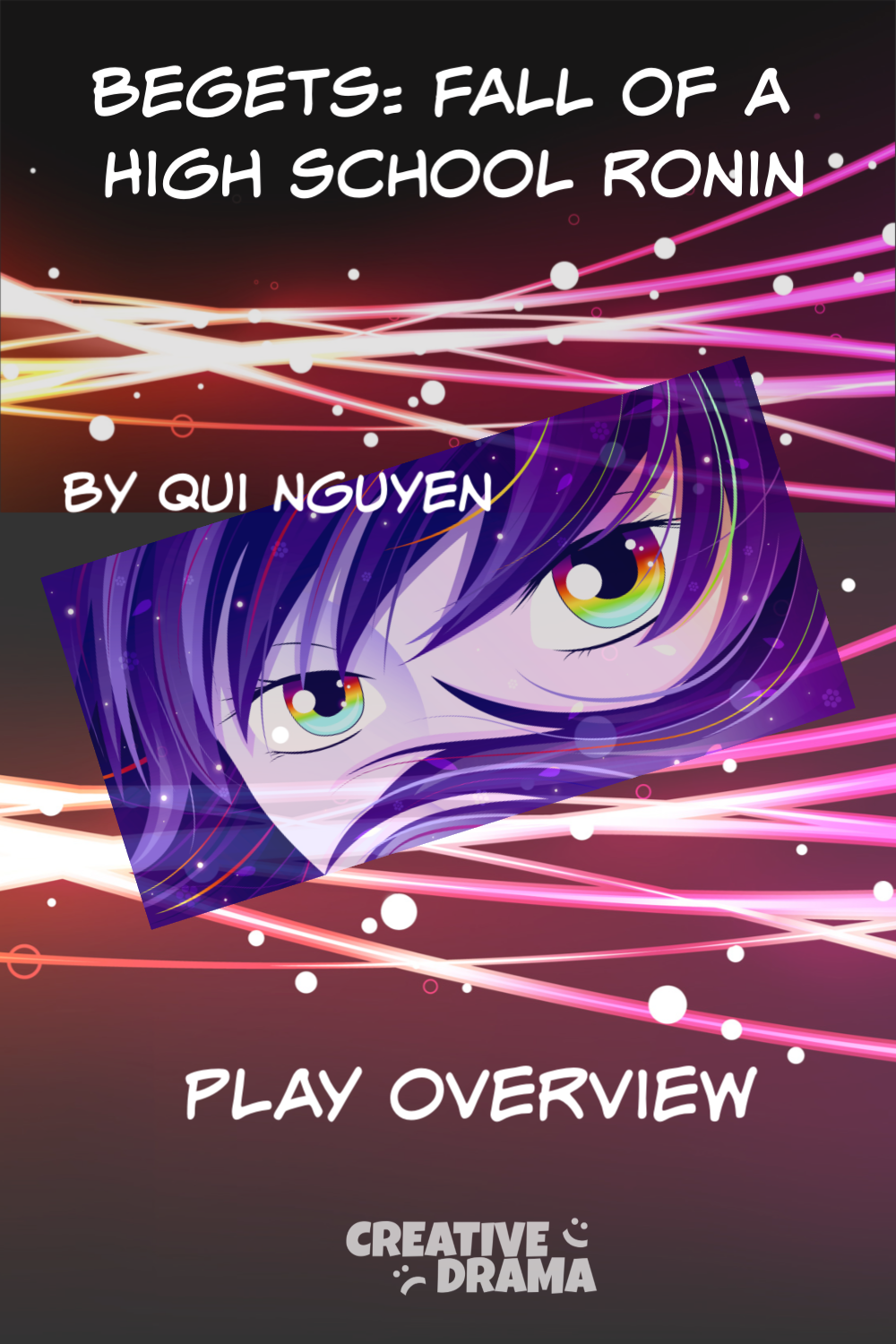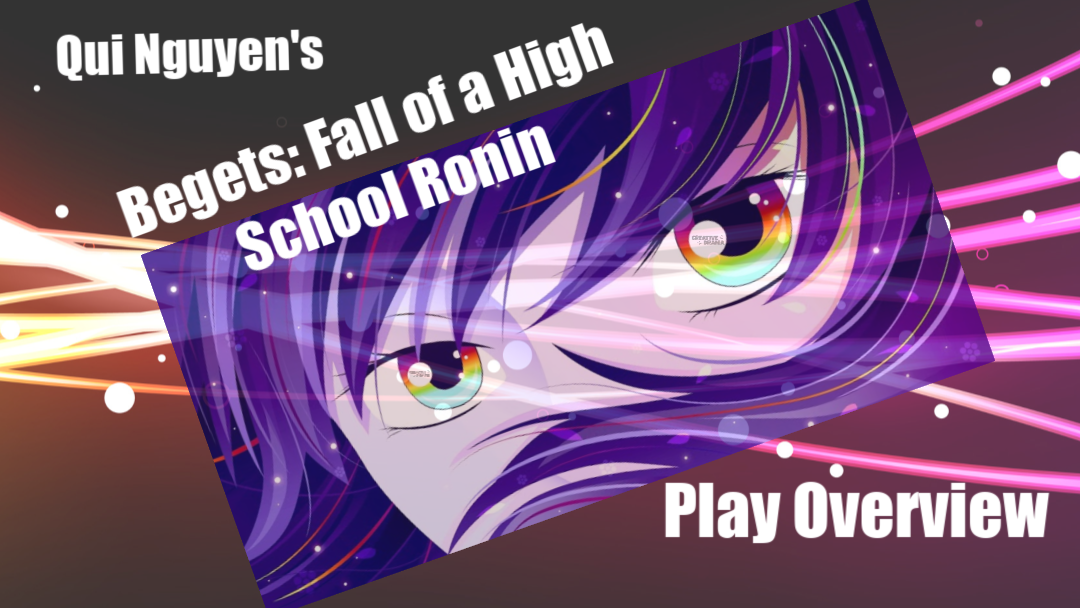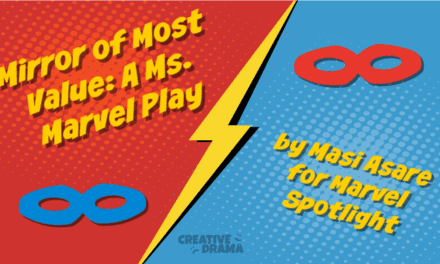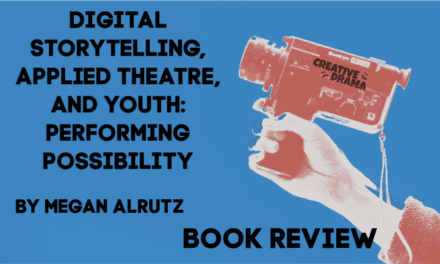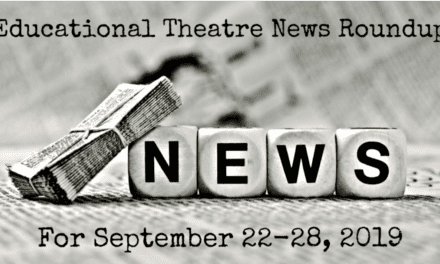SUMMARY
TITLE: Begets: Fall of a High School Ronin
AUTHOR: Qui Nguyen
LICENSING ENTITY: Samuel French
GENRE: Action Comedy
PLOT: After discovering her inner power and outer strength, Emi Edwards tries to turn the tables on the ruling factions at her dysfunctional high school.
CHARACTER BREAKDOWN: 14F, 7M, 2 Any Gender (fewer possible with doubling; possible extra ensemble members)
COSTUMES: Contemporary – Japanese Manga-influenced; Halloween costumes including a two-person boombox
SET REQUIREMENTS: Minimal- Japanese Manga-influenced; Banners for each clique
PROPS: Everyday objects, A Giant Robot
STAGING CHALLENGE: The fight choreography!
The summary of the production needs for Begets: Fall of a High School Ronin reads like it might be a perfect show for any high school. It has enough characters for an ensemble, more female than male parts, and a strong message. It has technical requirements that aren’t burdensome. Finally, the subject matter of high school cliques and outsiders is of interest to thespians and high school audiences alike. Most significantly, Begets would be a blast for a cast and crew to produce and perform.
I think Begets: Fall of a High School Ronin would be a terrific challenge for a well-established program or a particularly audacious director. There are several aspects of the show that might make it a daring choice for your particular school; see the Considerations section below.
THE EXPOSITION
Begets starts in media res – “in the middle of things” – a common convention in epic tales. This means the narrative travels into the past for some exposition, but only after the audience sees the conditions of the present. Thus, Prologue shows the same fight that happens near the play’s end. When Act One begins, the inciting incident that launched EMI on her quest has already happened in “real time,” but the audience doesn’t witness it until the beginning of Act Two.
Two actors play the protagonist – one as EMI, the person all the other characters interact with, and another as INSIDE GIRL, who is EMI’s self-image, with her inner thoughts and feelings. Nguyen’s description of his convention is absolutely wonderful –
“INSIDE GIRL dresses exactly like EMI, however she may not look like EMI at all physically. She may be of a different race. She may be taller. She may be thinner. It doesn’t matter.”
INSIDE GIRL speaks with confidence, self-awareness, and wisdom.
The school – with the very generic name “EHS” – is not a healthy environment for the students, or it would seem, the teachers. Each clique operates as its own fiefdom, with the leaders lording it over both outsiders and the underlings that are part of their group. There are two ineffectual administrators, and a just-out-of-college guidance counselor who hasn’t left high school emotionally. All of the cliques are terrible; the leaders are awful, and the guidance counselor is the absolute worst.
The audience first meets EMI in a Charlie Brown situation, sitting alone eating lunch and being ignored by everyone. Like many teenage girls, EMI found herself best friend-less – and all other friend-less – during the difficult transition to high school. EMI and MARY were inseparable through middle school and shared their first kiss. But having a best friend (and maybe more) to the exclusion of all others means that EMI has no one to turn to when MARY tries letting go of their tween geek obsessions, and then of her relationship with Emi. The machinations of MARY’s older “Queen Bee” sister ANDREA don’t help.
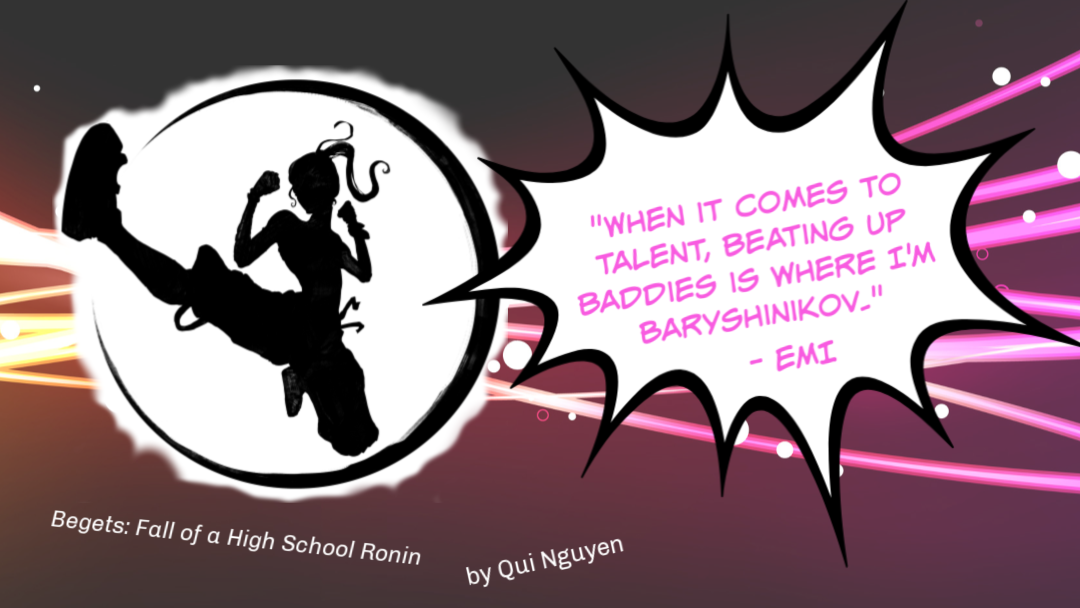
EMI, with the serendipity of being in the right place at a bad time, has discovered that her superpower is…
BEATING PEOPLE UP.
I know. I KNOW. Violence is NOT the answer. It’s never supposed to be the answer.
But when EMI started defending PATRICK, the nerdy freshman, against his bully, I started to root for her.
And I kept rooting for her…
…When she trained with JILLIE LEE to learn how she might take down the power structure at EHS.
…Even when EMI “took out” the leader of the Drama Club…who was, predictably, yelling, “NOT THE FACE!”
Once EMI knocked the leader of the Conservative Coalition “off her podium,” I was invested in EMI’s quest.
By the end of the first act, it seems as if EMI is going to get her best friend back, help the downtrodden at her school, and conquer her own self-doubt.
Even though INSIDE GIRL keeps reminding the audience that there’s going a be a fall, that she’s going to lose, Nguyen leaves enough space for the audience to hope.
There are two subplots going on in Begets as well. In one, LAURA, the girl who EMI was defending from bullies, – and the girl whose topless photos were posted online – develops a romance with TREY. TREY has been trying to be a boyfriend to MARY, but she’s not very interested in (what he sees as) typical boyfriend/girlfriend stuff like kissing. In the other, PATRICK, the nerd who asks for EMI’s help at the beginning of the play, learns that his online romance isn’t what it seems.
ACT TWO
Here’s what happens in the second act:
EMI and MARY get to confront one another about their friendship’s breakdown and their more-than-friendship feelings for each other.
We get to meet EMI’s parents after ANDREA, fearing for her status as shogun for the Royals, pretends to be a concerned administrator from EHS and reveals EMI’s new hobby of fighting. INSIDE GIRL has a lot to say about them.
EMI conquers a GIANT ROBOT. I repeat, a GIANT ROBOT. This is a daunting creative challenge for your cast and crew – how to make it, how to operate it – and it is part of a show-stopping moment in the play.
And for five brief, shining weeks, EMI and her pals rule the school. INSIDE GIRL is not impressed, but she can’t convince EMI to give up her endgame plan…
Which I will not reveal here, but it’s weird; EMI is still manipulating with violence, and her girlfriend seems to be okay with it.
By the end of the play, EMI hasn’t seemed to “fix” anything – I’m not sure that I was expecting her to – but the uncertainty adds to the message.
CONSIDERATIONS
Begets: Fall of a High School Ronin premiered in 2015 at the Professional Performing Art School’s Waterwell Drama Program in New York; PPAS is a school for working performers (and hopeful working performers) in grades 6-12. Waterwell commissioned the play and Nguyen worked with students and teachers in a workshop setting to develop it. Nguyen wrote Begets specifically for high school performers.
I think Begets would be a terrific selection for many high schools to produce.
However, I’ve assembled a list of “Considerations” to help teacher-directors decide if they’d like to get a hold of a perusal copy, or purchase one. These are aspects of the play that, in an ideal universe, wouldn’t cause a problem for a teacher-director. But if the powers that have to approve your production will have difficulty with any of the following, or you have members of the school community who will, be prepared to defend your choice.
Also, this list is just what I’ve noticed in the play that, based on my experience and knowledge of past challenges to educational theatre pieces, may cause an objection. If these aspects leave you undaunted, you should still read the script and decide, based on what you know about your community, if it will work for you.
- This is a tween-and-up audience show; the nuances of the themes and possibly the plot would be frustrating for most elementary school students to understand. Some schools have a standing rule that all productions must be “family-friendly;” it would be difficult to argue that Begets is appropriate for all audiences. (Maybe you want to argue against the standing rule first?)
- The high school milieu, most of its students, and the adults in the play are not aspirational. They are all making mistakes, choosing the wrong thing, or generally failing to be role models. This is of course, the point, and a teacher-director can make this clear in discussions. But critics may view these characters as ones high school students “shouldn’t be playing.”
- The cliques in the play are the Royals, the Burnouts, the Conservative Coalition, the Jocks, and the Marching Band. Again, they are all portrayed as awful. The Burnouts are the artists, which include the Drama Club. Your theatre kids will probably “get it,” understanding Nguyen’s satirizing of their worst traits. But if you have contingents in your school (or parents of those contingents) that will be offended by the negative portrayal of fictional groups somewhat similar to their own, be prepared.
- There’s not only a Conservative Coalition – self-nicknamed the “Teen Tea Partiers” – that gets a send-up, but also a guidance counselor who’s a Fox News devotee. It’s possible there are people in your community who won’t see the humor in these portrayal.
- There’s fighting. A LOT of fighting. EMI beats up several girls, five boys, and, with MARY’s help, a robot. PATRICK beats WALTER in the head with a rock. There could be objections to the stage combat in the play, or the portrayal of violence onstage (even at schools where the football team is exhorted weekly to “kill” their opponents).
- The dialogue in the play contains profanity, bullying, threats, sexual innuendo, and offensive language that mocks appearance, intellect, social skills, and sexual orientation. Nguyen shows his awareness of the more risky words in JILLIE LEE’s euphemistic line to COUNSELOR THERESA:
JILLIE LEE: Fog off.
EMI: But she didn’t say “fog.”
- There are several romantic relationships in the play. A boy and girl make out, two girls make out, and a boy pretends to be a girl online and falls in love with another boy.
- A character posts topless photos of herself online, then blames bullies for doing so. (These are only spoken about; the stage directions indicate that embarrassing photos of George W. Bush be shown in their place.)
- Most importantly, the show absolutely requires a director who has experience with fight choreography, or one who has the funds to hire a fight choreographer who will be able to train actors and stage the multiple combat scenes in the play.
THE PLAYWRIGHT
Qui Nguyen is an award-winning playwright and screenwriter; his play She Kills Monsters climbed to seventh place on the Educational Theatre Association’s list of most-produced high school plays in 2019. He spent time in the Marvel Studios Writers Program, and most of his plays reflect influences from the geek universe: comic books, martial arts movies, and anime. In fact, his theatre company, Vampire Cowboys, was the first one to be officially sponsored by NY Comic Con.
The podcast Variety Stagecraft has an episode – “Vampires, Cowboys and Stealth Diversity” – featuring Qui Nguyen.
OTHER NOTES
If you have a student looking for an audition or competition monologue who has some martial arts training, INSIDE GIRL’s monologue at the beginning of Act Two could make an impressive piece. It requires that the actor fight invisible foes in slow motion and in real time.
Here are production photos from the world premiere of the play – at the Professional Performing Art School’s Waterwell Drama Program in Manhattan – Qui Nguyen was the fight director.
Samuel French’s Breaking Character feature has several other geek-hero plays you can check out.
